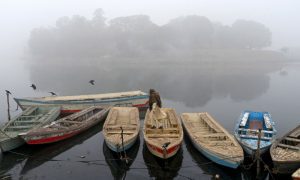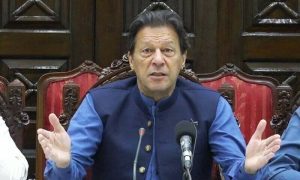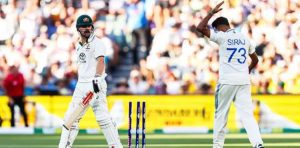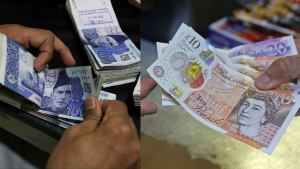
[ad_1]

Region’s proud history of sending sons into military service is also reflected in political landscape, with several ex-armed forces men being elected to office throughout Chakwal’s history.
They say there is not a single cemetery in Chakwal that does not have the grave of at least one fallen soldier.
Located around 106 kilometres from Islamabad, Chakwal has had a reputation for being a ‘martial area’ since the time of the British Raj, and its sons have been an integral part of the armed forces.
Being an arid region with little indigenous industry, the unemployed but stoutly well-built youth of the area were historically a good bet for British rulers as military recruits. Soldiers hailing from the region took an active part in both world wars, with several of its sons losing their lives on foreign shores and winning laurels from the British government, including the Victoria Cross. The area is also dotted with memorials and cannons that serve as a reminder of the region’s bravehearts.
Even after Partition, Chakwal continued its militaristic traditions, producing many generals and scores of other military officers. That none of its denizens have made it to the post of army chief is written off as the luck of the draw, but the area can definitely claim another service chief, former air chief marshal Nur Khan, as one of their own.
If history had taken a different route, the country’s first army chief may have been a Chakwal native. Army chief-designate Maj Gen Mohammad Iftikhar Khan was supposed to succeed General Douglas Gracey, but he was killed in a plane crash in 1949 before he could take charge.
He had nine brothers, six of whom were army officers. His elder brother, Gen Mohammad Akbar Khan, was the senior-most general in the army at the time of Independence, but he declined the offer of the top job.
The military tradition is still strong in the area, and some of those who have retired from active service have tried and proven their mettle in the political arena as well.
One former general hailing from the area, Abdul Majeed Malik, was elected MNA five times, while his nephew retired Major Tahir Iqbal — the current PML-N candidate from NA-58 — has been elected to the National Assembly twice before.
Another ex-general, Abdul Qayyum, has been a senator, while two of the current Pakistan Tehreek-i-Insaf (PTI)-backed candidates, Ayaz Amir in NA-58 and Sultan Surkhru Awan from PP-23, have also served in the army.
Before and after Partition
Politics in this ‘martial area’ of North Punjab, where the rural population decides the fate of contesting candidates, has been revolving around baradris (clans) since the Ayub Khan era.
Until 1985, Chakwal and Talagang were tehsils of Jhelum and Campbellpur (later Attock) districts, respectively. It was only in the mid-80s that Chakwal was upgraded to the status of a district and Talagang was annexed with it.
The most dominant tribe in Chakwal is the Myer Minhas Rajput. In some villages, the Myers are called ‘Sardars’ and in other areas, they are known as ‘Chaudhrys’. The ancestral chiefs of Myers were known as ‘Rajas’, and their heirs still use the title in their names. Several generations down the line, it is still the Sardars of Chakwal who matter the most in the area’s politics.
Raja Mohammad Sarfraz Khan of this tribe was the first legislator from the area to make his way into the Punjab Assembly in 1927. He remained a member of the legislative assembly (MLA) for three decades, both before and after Partition.
Although he was defeated in 1951 by Ayaz Amir’s father, Chaudhry Mohammad Amir Khan, the result was overturned after Raja Sarfraz challenged it.
The 1960s saw Raja Sarfraz’s relative, Sardar Khizar Hayat of Kot Chaudhrian, and his son-in-law, Sardar Mohammad Ashraf Khan from Dullah, into primacy.
Sardar Khizer Hayat was the first politician from Chakwal to be elected as MNA from the NW-22 constituency in 1962’s indirect elections, while Sardar Ashraf was elected to the West Pakistan provincial assembly.
At the time, NA constituencies in West Pakistan were known by the moniker National West (NW), while those in East Pakistan (present-day Bangladesh) were referred to as National East (NE) constituencies. NW-22 encompassed a sprawling area, comprising Jhelum and Attock.
Sardar Khizer Hayat was re-elected to united Pakistan’s fourth National Assembly in 1965, while Sardar Ashraf also reprised his role as a provincial legislator.
Both men dominated the region’s politics until the 1970 general elections, when the two became rivals for the same seat, with Sardar Khizer contesting on a Muslim League Conventional ticket, and Sardar Ashraf on a Muslim League Council ticket.
PPP’s entry
This rivalry divided the votes of the baradri which had kept them in power thus far, and it happened at the same time as a newly-established Pakistan Peoples Party (PPP) was about to sweep the polls in West Pakistan.
The PPP picked Chaudhry Mohammad Amir, Ayaz Amir’s father, who trounced both Sardars by a margin of some thousand votes to claim NW-33. Meanwhile, the novice, Malik Mohammad Sadiq from Jhamra village, who had recently returned from Denmark, clinched NW-34 under the PPP banner.
But Amir was murdered in August 1974 and in the by-election, PPP’s Raja Nazar Hussain Keyani from Bhoun village managed to clinch the seat. Khizer Hayat and Ashraf Khan made a comeback in the 1977 elections, with the former claiming what had now become NA-45, and the latter becoming MPA and holding the portfolio of livestock and forests in the Punjab cabinet.
But the ill-fated assemblies of 1977 only lasted three months, as Bhutto’s government was toppled by Gen Ziaul Haq.
Consecutive victories and IJI
In 1985, the area entered the era of Abdul Majeed Malik, who emerged as a serious rival to Sardar Ashraf Khan, winning five consecutive elections from 1985 to 1997. In the first four elections, he defeated Ashraf Khan, while in 1997 he won against PPP’s Raja Munawar Ahmed.
But with the 1985 polls held on a non-party basis and the Islami Jamhoori Ittehad (IJI) launched to counter the PPP in 1988, winds of political change began to blow through the region.
In Chakwal, Gen Majeed Malik emerged as the new face of IJI while Sardar Mansoor Hayat Tamman of Talagang was the party’s man in NA-44.
However, the presence of Sardar Ghulam Abbas among those elected on the four Punjab Assembly seats from the area heralded the return of an old clan. Sardar Ghulam Abbas was a paternal cousin of Sardar Khizer Hayat. He was beaten in 1988 and 1990 by Fauzia Behram, the first woman lawmaker from Chakwal, on provincial assembly seats.
Meanwhile, Malik Salim Iqbal of Talagang, who also served as provincial minister four times, became the most powerful politician in his area.
The elections of 1993 brought another new face, Raja Sultan Azmat Hayat from Choa Saidan Shah, to PP-17, while Sardar Ghulam Abbas made his way to the Punjab Assembly on a PPP ticket from PP-18.
Meanwhile, NA-44 also got a new face with the victory of PPP’s Sardar Mumtaz Khan Tamman.
The 1997 elections saw Sardar Mansoor Hayat Tamman elected MNA for the second time from NA-44, while Gen Majeed remained undefeated on NA-43.
It was during this election that Ayaz Amir won the PP-18 seat on a PML-N ticket. However, he later had to resign and Malik Tariq Iqbal succeeded him after a by-election.
Musharraf and beyond
The 2002 general elections brought another change, when the Pakistan Muslim League (PML-Q) became the new “king’s party” and PML-N stalwart Gen Majeed Malik became one of its leading lights.
Although he was unable to contest the elections due to the graduation condition, he fielded his nephew, retired Major Tahir Iqbal, who clinched the election by beating Ayaz Amir with a narrow margin. All four Punjab Assembly constituencies also went to the PML-Q.
The 2008 electoral battle saw PML-N’s Ayaz Amir in NA-60 and Sardar Mumtaz Khan Tamman in NA-61 emerge victorious as MNAs.
In 2013, the PML-N grabbed all six seats in the area, with Tahir Iqbal in NA-60, Sardar Mumtaz Khan in NA-61, Chaudhry Liaquat Ali Khan in PP-20, Malik Tanvir Aslam in PP-21, Sardar Zulifqar Ali Khan in PP-22 and Zahoor Anwar in PP-23. Both Chaudhry Liaquat Ali and Zahoor Anwar passed away in 2017. Liaquat’s son, Chaudhry Sultan Haider Ali, and Zahoor Anwar’s nephew and Malik Salim Iqbal’s grandson, Shehryar Malik, retained the seats in by-elections.
As the general elections of 2018 witnessed a spike in PTI’s popularity, Sardar Zulfiqar Ali Dullah became MNA from NA-64 while Parvez Elahi of PML-Q was elected from NA-65, courtesy a seat adjustment with the PTI.
PTI’s Raja Yasir Humayun Sarfraz and Sardar Aftab Akbar (the former tehsil nazim) got the provincial seats of PP-21 and PP-23 and PML-Q also bagged the PP-24 seat, with Hafiz Ammar Yasir becoming MPA. PML-N could only claim one seat in PP-22, with the victory of Malik Tanvir Aslam.
The current battle
The constituencies of the National Assembly once again have been renamed due to delimitations. The NA-64 constituency has now become NA-58, while NA-65 is now NA-59.
The PML-N has again fielded retired major Tahir Iqbal in NA-58 while PTI’s man in NA-58 is stalwart Ayaz Amir. Former PTI MNA Sardar Zulifqar Ali Khan Dullah, who joined the Istehkam-i-Pakistan Party (IPP), just weeks ago is now the PPP’s candidate after he failed to navigate a seat adjustment with the PML-N in NA-58.
Even with the PTI deprived of its electoral symbol and the stage apparently set for PML-N’s smooth sailing into power, candidates from the beleaguered former party are still in a position to pose a formidable threat to the party of the Sharifs.
A case in point is NA-58, and its two allied constituencies of PP-20 and PP-21, provided the candidates’ right to campaign is not usurped.
On the other hand, in Talagang’s NA-59, PP-22, and PP-23 constituencies, the PML-N finds itself in a secure position, following the elimination of potential threats such as PTI President Parvez Elahi (NA-59) and his lieutenant in PP-23 Hafiz Ammar Yasir. The duo had their nomination papers rejected, rendering them unable to take part in elections.
Additionally, former PTI MPA from PP-22 Sardar Aftab Akbar has distanced himself from the party through the customary video statement following the May 9 violence. With no viable candidates remaining, the party has fielded, albeit reluctantly, a comparatively weaker candidate against the formidable Sardar Ghulam Abbas of PML-N.
Consequently, PTI is left without potential contenders in NA-59, PP-22, and PP-23, who could take on their PML-N rivals.
Even though the odds seem stacked against them, Ayaz Amir’s position looks stronger than his two rivals as he is managing to capture the attention of voters through an organised and energetic campaign. The PML-N has, meanwhile, fielded Chaudhry Haider Sultan in PP-20 and Malik Tanvir Aslam in PP-21 against PTI’s Chaudhry Ali Nasir Bhatti and Raja Tariq Afzal Kalas, both of whom seem to be in a stronger position than the PTI’s contenders.
Malik Tanvir Aslam is remembered for executing several uplift projects in the area, while Chaudhry Sultan Haider’s family has been winning the PP-20 over seven terms.
Header image created with AI
[ad_2]
Source link






